AOpen AK89 Max: From Ugly Duckling to Swan
by Wesley Fink on April 21, 2004 4:16 PM EST- Posted in
- Motherboards
AOpen AK89 Max: Basic Features
The AK89 Max is the top model in the AK89 series. There are also two other versions of the AK89 board with reduced features, namely the AK89-L and AK89-N, but not all versions are available in all markets. The AK89 MAX is the only version of the 3 that includes SATA, Firewire, and a special PCI slot with an independent Power Supply.| AOpen AK89 Max Motherboard Specifications | |
| CPU Interface | Socket 754 Athlon 64 |
| Chipset | nVidia nForce3-150 |
| Bus Speeds | 200MHz to 250MHz (in 1MHz increments) |
| PCI/AGP Speeds | Adjustable. 66 to 100 in 1 MHz increments |
| Available CPU Ratios | CPU ratios below rated multiplier can be selected in the range of 4x-16x |
| Core Voltage | Normal, 0.8V to 1.55V in .025V increments |
| DRAM Voltage | Normal, 2.50V to 2.80V in 0.05V increments |
| AGP Voltage | 1.5V, 1.533V, 1.566V, 1.6V |
| Memory Slots | Three 184-pin DDR DIMM Slots Single-Channel Configuration Regular Unbuffered Memory to 2GB Total |
| Expansion Slots | 1 AGP 8X Slot 5 PCI Slots (1 Special PCI with Power Supply) |
| Onboard Serial ATA RAID | Silicon Image 3114 (4 Drives, 0, 1, 0+1) |
| Onboard IDE | Two Standard nVidia ATA133/100/66 (4 drives) |
| Onboard USB 2.0/IEEE-1394 | 6 USB 2.0 ports Two FireWire ports provided by Agere FW323 |
| Onboard LAN | Realtek RTL8110S Gigabit LAN |
| Onboard Audio | Realtek ALC655 codec AC '97 2.3 6-Channel with UAJ |
| BIOS Revision | 1.06M (4/12/2004) "Die-Hard II" Dual BIOS |

The packaging is the same green on white theme that we first saw in the AK86-L review.
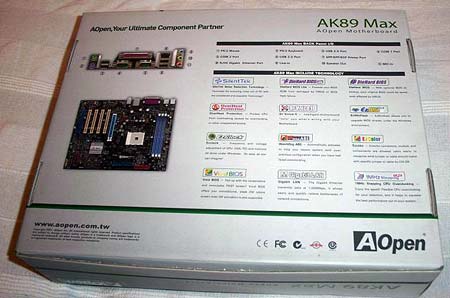
As a top-end AOpen board, you get the full range of features including SilentTek smart fan controller to lower system noise, the Die-Hard Dual BIOS similar to that seen on Gigabyte top-end boards, EZWin Flash for BIOS updates from Windows, Watch Dog for recovering from bad overclocks, and the EzClock utility for overclocking while in Windows.
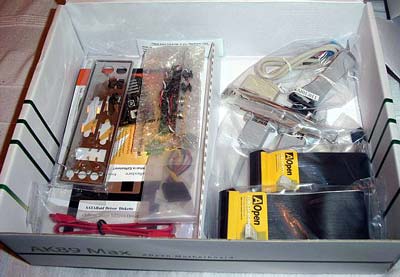
AOpen includes a full set of black cables to match the motherboard. Also included are 3 accessory brackets that provide 2 firewire slots, 2 additional USB and a game port, and a 4 port digital/optical IO bracket. We were also happy to see that AOpen included a floppy with the Silicon Image SATA drivers. Many manufacturers have started leaving this necessity out of the box, forcing the installer to find another PC to create the install floppy.
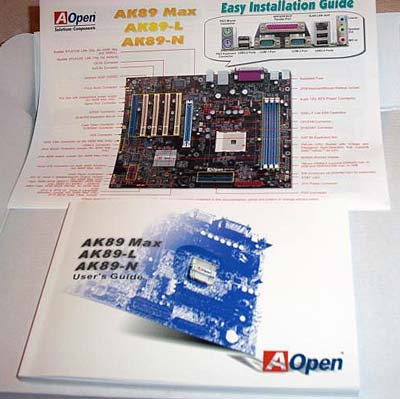
We often see Illustrated Easy Installation Guides included in boards from the top motherboard manufacturers. The purpose of the quick guide is to describe all the ports clearly to allow complete board installation without having to refer to the manual. AOpen does one of the best jobs here, since all ports and jumpers are clearly illustrated and described. The thick manual allows users to find more detail and includes complete information on how to get Technical Support and how to contact AOpen.

The AK89 Max back panel includes 4 USB 2.0 ports, 3 individual mini-jacks for audio, Gigabit LAN, PS2 mouse/keyboard ports, Parallel, and 2 serial ports. There are additional headers on the motherboard for the 3 included accessory brackets.
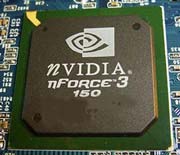
The nVidia nForce3-150 is a single-chip chipset with a 600 Hyper Transport speed and very few features built into the chipset. Details of the nF3-150 architecture were covered in our Athlon64 motherboard launch review. A large passive heatsink is used on the nF3-150 instead of an active solution used in some other designs. However, we did not have any overheating problems in our benchmarking or overclocking tests of the AK89 Max.

The Silicon Image 3114 provides 4 SATA connectors and SATA RAID 0, 1, and 0+1 capabilities.
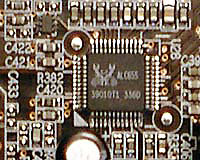
The AOpen AK89 Max uses the Realtek audio codec called ALC655, which is compliant with the latest AC '97 Rev. 2.3. This audio codec features 6-channel sound and UAJ or Universal Audio Jack, with a better than 90db signal-to-noise ratio. This allows automatic jack programming as we've seen on boards based on Intel's 865/875 chipsets. The ALC655 is quite similar to the Realtek premium ALC658 sound solution. Additional information and specifications are available at Realtek.
An SPDIF bracket is included in the AK89 Max package, providing both coaxial and optical IO connections.
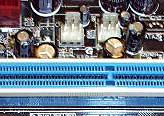
AOpen provides five fan headers on the AK89 Max, which should handle just about anything you can think of doing with fans and fan control. Fans can be controlled with "Silent Tek" in the AK89 Max BIOS.

The AK89 Max includes Realtek 8110S Gigabit LAN. Dual color LEDs in the LAN socket indicate 10/100 or Gigabit operation.
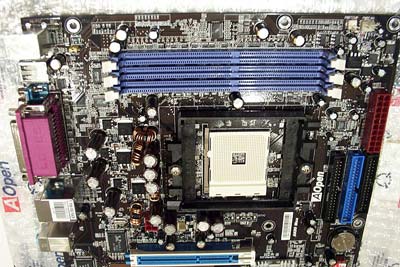
Three DIMM slots support standard unbuffered Single-Channel memory. AOpen claims support for up to 2GB of DDR400 memory in 2 DIMMs, and up to 3GB of DDR333 or slower memory in 3 DIMMs.
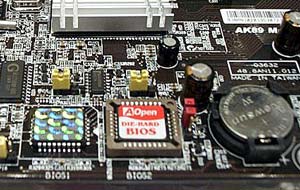
Dual BIOS is very useful for recovering from a bad BIOS flash, a far too common reason for motherboard failure. AOpen and Gigabyte are two companies that provide this feature on their top motherboards. AOpen call their dual bios solution "Die Hard II".










23 Comments
View All Comments
retrospooty - Friday, April 23, 2004 - link
Am I the only one that found this artcle hard to follow ? Its all over the place ... What the hell was being tested ?cowdog - Thursday, April 22, 2004 - link
Thanks for the information.BTW, I finally did get through to AOpen, and they have been very prompt and helpful. I must have fallen through the cracks or something earlier.
Wesley Fink - Thursday, April 22, 2004 - link
Cowdog -I used our standard Mushkin/OCZ 3500 at default speed. Above 233, I used OCZ 3500EB to DDR500, and OCZ 4200EL to DDR550. if you look closely at the screen shots the memory is identified on the overclocks. As you state, BH6 can't reach these levels.
AOpen tells us the board would require a revision to allow an increase in vcore, and with the nF3-250 near, a new rev will not appear with the 150. They can't modify the vCore on this board with just a BIOS update. vdimm and higher FSB may be a possibility - we have requested those changes - but it is more likely these will come with the 250 version.
cowdog - Thursday, April 22, 2004 - link
FYI: This seemed as good a place to post this as anywhere else. Just came across a new bios, 1.07"For AMD recommended,memory clock will set to DDR333 when DIMM1 and DIMM2 plugged double side DDR400 memory."
Two things:
1. BIOS defaulted to 200x11 for me, which isn't a good thing for an A64 3200
2. I have no option for DDR400 in the bios with 2x246MB Mushkin Lv II PC3500.
3. When I tried to lower the multipler, the bios gave me an error at POST (safe mode or something like that). Then even if I selected bios defaults I had the same message. I reset cmos and it worked, although cpu frequency went back to the 200x11.
Might want to be leary of bios 1.07, although my system may simply be whacked.
cowdog - Thursday, April 22, 2004 - link
Wesley, I must admit that I haven't tried Dr. AOpen; I missed that. I did fill out their tech support form (with serial number, etc.) three times. This third time (last night) I did receive an automated reply for the first time. I kept screen shots of the previous forms, and I know my email was right. I'm not sure what happened. Anyway, I'll try Dr. AOpen as well, thanks.Couple of things to add:
1. As far back as the official 1.06 bios, I was able to change multiplers (only downward, of course) using Clockgen. I found that clockgen would work if I set the multiplier lower in the bios, even though that did not change the multiplier at post. 1.06 m bios now changes the multiplier at post, as you note. Funny thing too, after I updated to 1.06m, the default multipler was 4.
2. I don't understand why AOpen won't open up the cpu and dimm voltages as they did with the AK86-L. As you note, the AK89 Max is their current A64 flagship. Why add features via bios update to the AK86-L but not do similar for the AK89 Max? Unless, of course, those features can't be added with a bios update. Do you know?
3. When you overlclocked the memory 1:1 to 250Mhz, were you using the OCZ or Mushkin memory that you referenced earlier in the article? I am unable run some Mushkin BH-5 memory 1:1 at anything higher than 230Mhz (clockgen) and 210Mhz (bios) with the multiplier way down and LDT at 3 or 2.5 even though I can run the same memory at speeds higher than 250Mz on another board. Same thing with some Corsair LL v.1.1 memory. Just curious. Perhaps the cpu is the limiting factor; is there that much variability?
Anyway, thanks for a really nice and thorough review. I am trying very hard to like this board (and AOpen) and your review renewed my motivation.
Wesley Fink - Wednesday, April 21, 2004 - link
#7 - The Asus K8V is based on the VIA K8T800 chipset which has no capability at all for a PCI/AGP lock. We have found the performance of the VIA and nForce3-150 to be about the same at stock speed, but the VIA is simply not cpable of avchieving the overclocks we have reported in this review.The K8V performs about like the MSI K8V Neo which is included in our benchmarks.
Modal - Wednesday, April 21, 2004 - link
I wish you would have done some comparisons with the ASUS K8V Deluxe as well, as this seems to be quite a popular board for Athlon64 machines (plus, I'm thinking about using it for my next build...). Oh well...Wesley Fink - Wednesday, April 21, 2004 - link
#5 - Have you tried Dr. AOpen on line? If nothing has worked please email me your details and I will forward your email to contacts at AOpen.Both Evan Lieb and I have had very positive Support expereinces with AOpen. If others are getting different treatment it is important to know that and report it in our reviews.
gimpsoft - Wednesday, April 21, 2004 - link
is this a Real AGP /PCI lock ???i heard there way to mod the bios to lock but not the same as hardware Agp/pci locks
well something like a sofmod ill see if i can find the link
may be a this must buy board i got a via KT800
i can do 3000+ 10 X 250= 2500MHZ but my radeon 9800pro & audigy bitch they say to high =) PCI: 41 APG: 83
bigtoe33 - Wednesday, April 21, 2004 - link
2-I was quite impressed by te FSB's the AOpen was able to hit and did feel the review was there just to show what the board is capable of.I also have this board and i would say 1:1 will be pretty limited due to 2.8V vdimm max.
Also it was nice to see a comparison of 3dmark although i know this is not a bench Wes uses.
Overall i think the review showed the board has awesome potential and proved that boards can become awesome with a "tuned" bios ;-)